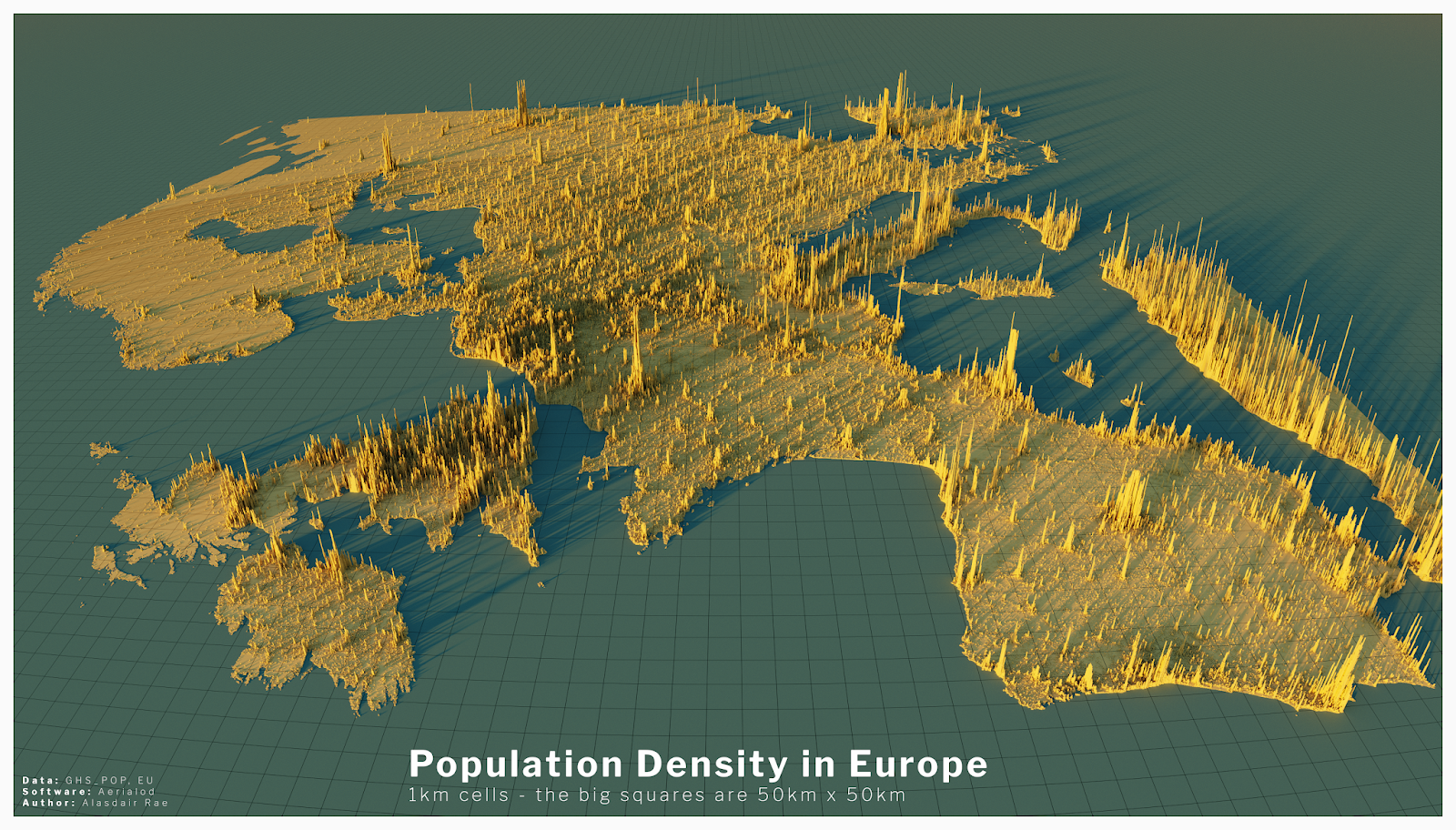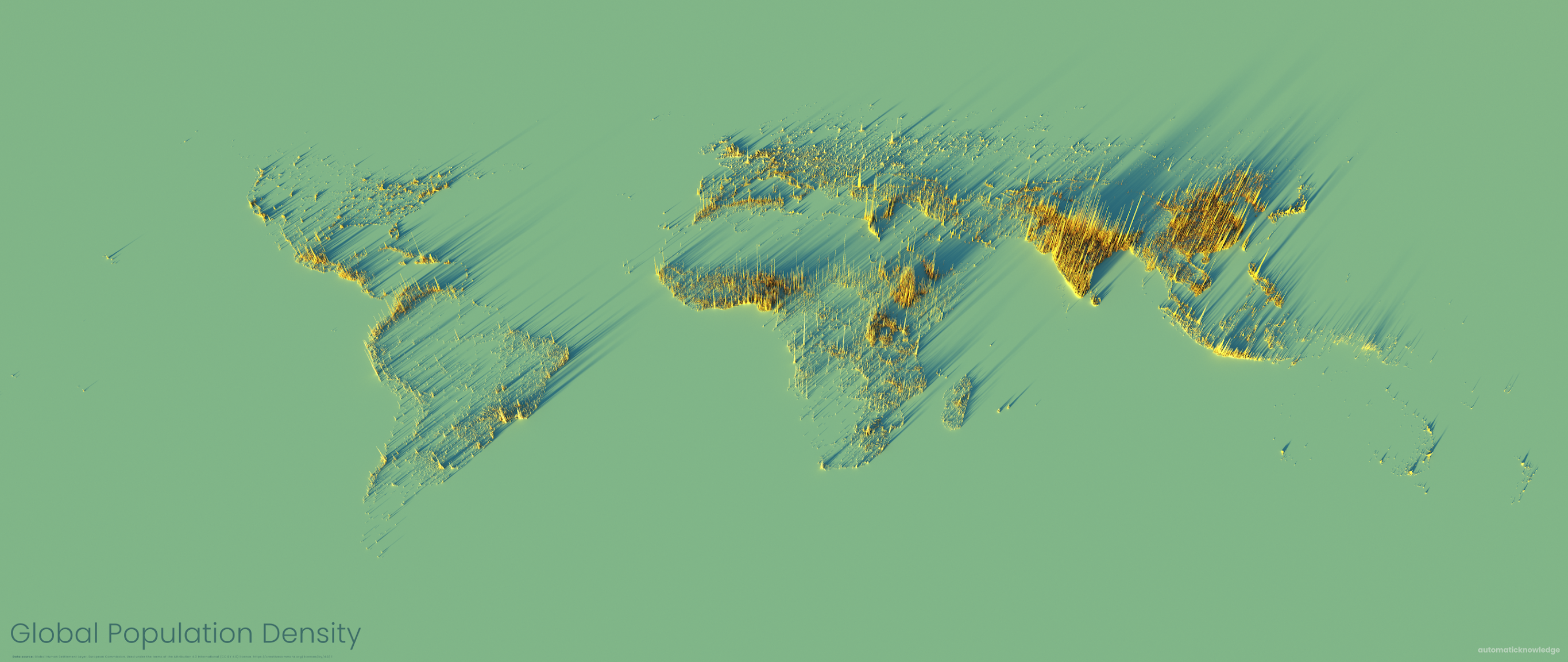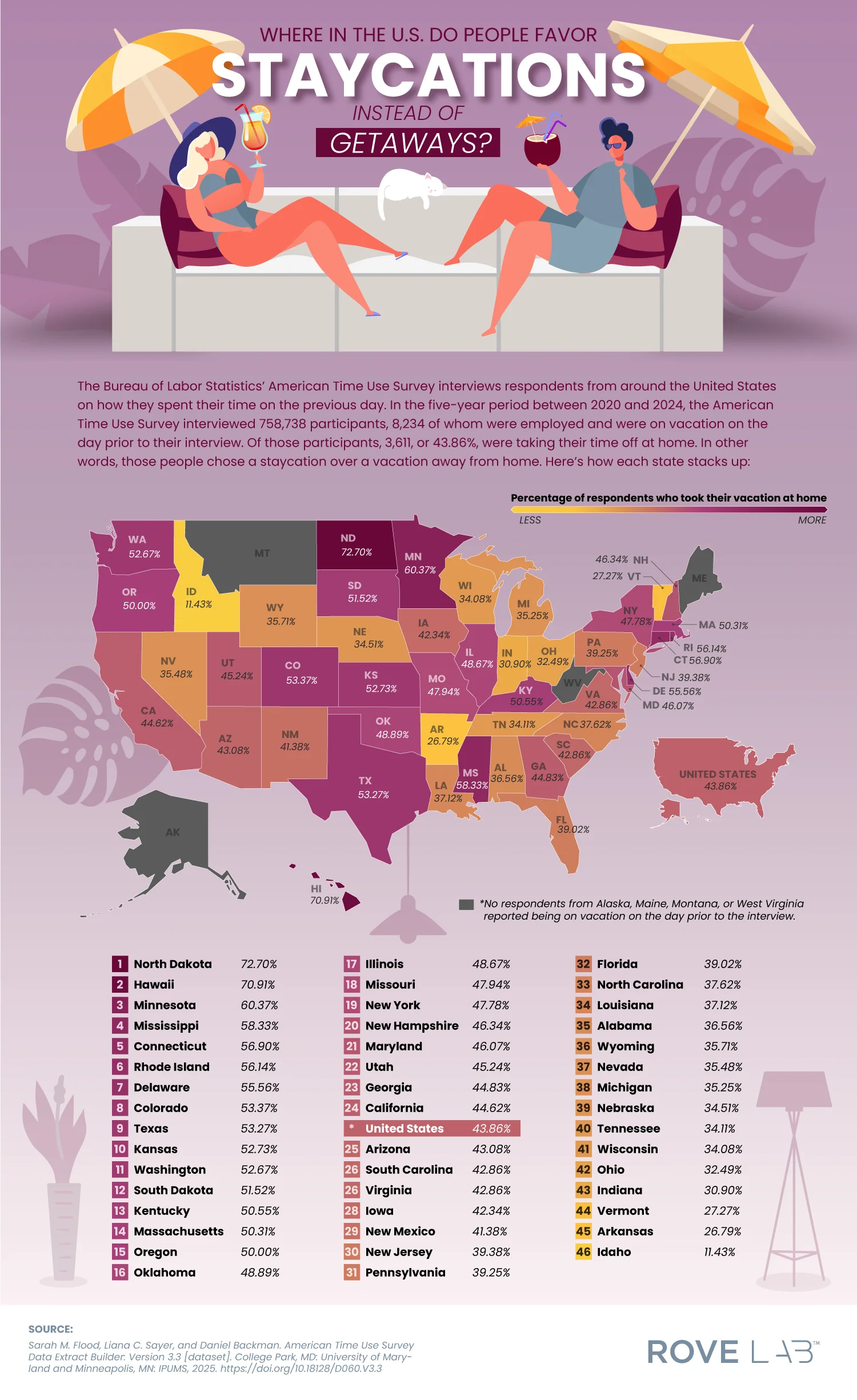Maps
The Population Density of Europe (and the World) in Two 3-D Maps
How many people live in Europe? The population of Europe is around 745 million people, or 10% of the world population. Internationally recognized data analyst, mapmaker, author, and visual storyteller Alasdair Rae has transformed this figure into a captivating population density map of the entire continent! Check it out:
Click below to zoom
Rae states: “The maps below use 1km x 1km data and the height of the bars represents the number of people living in any one square. The big squares are 50km x 50km (about 30 miles) and are there to provide sense of scale. The highest 1km densities are found in Spain and France, and Madrid, Barcelona and Paris in particular where you get values of more than 50,000.” You can explore more detailed sections of Europe here, as well as the creator’s insights and methods. You can also other fascinating data visualizations, such as the most densely population square kilometer in every U.S. state!
This got me thinking – what would an entire world map made like this look like? He actually made a complete map too! I wanted to provide both maps to provide a more “big picture” understanding of scale.
Click below to zoom
As you can see, in the grand scheme of the whole planet, Europe’s population density seems so humble. So what are the most densely populated cities in the world based on people per square kilometer? Try to take a guess based off of this map (test your geography knowledge!) and then check the list:
- Manila, Philippines (Asia) – 43,062
- Mandaluyong, Philippines (Asia) – 38,495
- Pateros, Philippines (Asia) – 37,061
- Caloocan, Philippines (Asia) – 31,233
- Bnei Brak, Israel (Asia) – 30,001
- Kathmandu, Nepal (Asia) – 29,161
- Dkaka, Bangladesh (Asia) – 29,069
- Makati, Philippines (Asia) – 28,975
- Port-au-Prince, Haiti (North America) – 27,395
- Levallois-Perret, France (Europe) – 26,713
The European city with the highest population density is Levallois-Perret in France, but it is nearly 20,000 people per square kilometer less than Manila, the most densely populated city in the world. While Americans in New York City or Los Angeles may fret over crowds and traffic, the truth is, none of America’s cities even rank in the top 50 for population density.
Maps
Study Reveals Top American Staycation Destinations
Many Americans find that staycations can be just as relaxing as a getaway vacation, but without the expense and hassle. For people who appreciate their home and community, a staycation is a perfect choice to recharge. The team at Rove Lab studied where staycations are the most popular and analyzed data to determine the ranking.
Click below to zoom.
Here are the top 10 places where staycations were most popular:
- North Dakota
- Hawaii
- Minnesota
- Mississippi
- Connecticut
- Rhode Island
- Delaware
- Colorado
- Texas
- Kansas
North Dakota comes first, and maybe that’s no surprise when 22 million visitors come to the state every year to explore national parks, world-class hiking, and other attractions. North Dakota is a peaceful, beautiful state where people can make the most out of a staycation. Hawaii comes in second place for similar reasons. Hawaii is a dream vacation destination for people all over the world. There’s no need to stray far when you can relax on some of the world’s best beaches in your own backyard. But there’s another factor to consider for Hawaiians. It’s an expensive state to travel in and out of. Most people need to fly to leave the islands, and that airfare is costly because of Hawaii’s isolated location.
There are many benefits to taking a staycation beyond saving money on transportation and lodging. A staycation offers the chance to sleep in, appreciate your community and home, and practice hobbies and self-care. You can also prioritize spending time with people you love and pets you can’t bring on vacation. There’s no need to pack, no reason to rush to the airport, and you can take a break that helps the environment by cutting the carbon emissions of travel.
There are so many benefits to taking a staycation. They reduce cortisol, the stress hormone, which is essential for our overall health and happiness. The only real benefit missing from a staycation is the mass of new opportunities. New experiences form new neural pathways in our brains, and that helps us see things from new perspectives, which can be a huge mood boost as well as enhancing problem-solving skills. There are ways to have new experiences on a staycation, too. You can refresh and redesign your living space for a new environment. You can treat your community like you’re a tourist there. Look for new places and experiences you’ve never had and indulge with excitement and an open mind.
Staycations remind us that we don’t have to run away to seek out rest. The best adventures can be quiet ones, like an afternoon drive to a new café or restaurant, a hike you’ve never been on, or enjoying the view from your own porch. It’s a call to reconnect with your own home and spend time exploring hidden gems in your local city. You can read, garden, or explore your surroundings. No matter what you choose, you’ll finish refreshed, and this Rove Lab study shows that many Americans have already experienced the benefits of a staycation.
Charts
These States Have the Cleanest Homes in the U.S.
The Oxi Fresh team has revealed the state of home cleanliness across the United States with a map ranking states by their score on the custom-made Oxi Fresh Home Cleanliness Index. Cleanliness can vary by cultural definitions and factors like busy lives can make our homes less clean than we would like. Studies have found that Americans spend about eight hours a month cleaning their homes. The team offers us a more in-depth look at the state of American cleanliness in their maps.
Click below to zoom.
The team formed the Home Cleanliness Index based on responses to survey questions. Five questions assessed how often residents perform specific cleaning tasks, like vacuuming, dusting, cleaning bathrooms, and changing bed sheets. They were also asked to rate their home’s cleanliness, the amount of clutter in their home, and how comfortable they would be with unexpected guests seeing their home in its current state. Lastly, the team asked whether residents in these states use a professional cleaning service.
These 10 states had the highest scores on the index:
- Wyoming
- Delaware
- Rhode Island
- Kansas
- Iowa
- Idaho
- Minnesota
- Arkansas
- Connecticut
- Tennessee
Wyoming residents are the cleanest, and they know it! 96% of them would be proud to have unexpected guests over who see the state of their home as it is. Wyoming homeowners deep-clean their carpets the most, mop the most, and change their bed linens the most often. It seems Wyoming homemakers prioritize cleaning and take great pride in their homes.
On the other side of the coin, these were the states with the lowest scores:
- New Hampshire
- North Carolina
- Maryland
- Maine
- Oregon
- Oklahoma
- Hawaii
- North Dakota
- Washington
- Utah
Utah had the lowest score overall at 69.76 out of 180 points. Utah residents reported the lowest scores for home cleanliness, but their data lends some credence to this. They dust, vacuum, and mop the least frequently. Utah may struggle with cleanliness due to its poor air quality. It has some of the worst air quality in the United States, with dust drifting in from the Great Salt Lake playa, as well as high emissions from gasoline vehicles and wood-burning stoves. Utah residents may feel they’re fighting a losing battle against dust, dirt, and grime and have lowered their standards.
There are many fun and interesting facts to glean from the team’s data. Delaware residents vacuum and mop the most, while Vermont residents maintain the cleanest kitchens with the highest number of kitchen counter wipe-downs. People in Iowa are the most likely to hire a professional cleaner. Arizona residents mop the least, maybe because the dry environment keeps out mud. Georgia and Arizona residents vacuum their carpets the least, but perhaps carpets and rugs aren’t as popular in these warm states. The data gathered here provide numerous opportunities to reflect on how various state factors may influence cleaning standards and norms.
Charts
Map Shows the Most Bilingual Cities in America
The United States is home to a diverse array of cultures, ethnicities, and languages. It attracts visitors and immigrants from all around the world, so it’s easy to find people who can speak another language in addition to English. Census Bureau statistics show that 21% of Americans are bilingual. The team at Preply took a deep dive into this data by determining which cities have the most and least bilingual residents.
Click below to zoom.
 The team defined bilingual as people who report speaking both English and one additional language “very well,” which would mean functioning at a fluency level in two languages. They created two maps to show the results. According to the team’s data, these cities have the most bilingual people in America:
The team defined bilingual as people who report speaking both English and one additional language “very well,” which would mean functioning at a fluency level in two languages. They created two maps to show the results. According to the team’s data, these cities have the most bilingual people in America:
- El Paso, Texas
- Los Angeles, California
- San Jose, California
- San Antonio, Texas
- New York, New York
- Houston, Texas
- San Diego, California
- Phoenix, Arizona
- San Francisco, California
- Dallas, Texas
In El Paso, the majority of the population speaks Spanish, which has been the case since 1965. Seven out of ten residents speak a language other than English. El Paso is located very close to the Mexican border, resulting in a high presence of immigrants, visitors, and family ties with Mexico. The same is true in Los Angeles, where nearly half the population is of an ethnic group that speaks Spanish. Overall, the most common second language spoken in the U.S. is Spanish, although you’ll find a wide variety of languages across the country.
As for the least bilingual cities, the team found that these 10 cities take the top spots:
- Detroit, Michigan
- Indianapolis, Indiana
- Nashville, Tennessee
- Jacksonville, Florida
- Columbus, Ohio
- Washington, D.C.
- Charlotte, North Carolina
- Oklahoma City, Oklahoma
- Philadelphia, Pennsylvania
- Seattle, Washington
Detroit may have the fewest bilingual speakers due to its shrinking population. It’s difficult to have diversity of cultures and languages in a small population. As industries shift location, sometimes you see certain populations follow. Detroit is known for auto manufacturing, but that industry has shrunk considerably since the city’s heyday. These statistics suggest that economics can have an impact on bilingual populations.
After Spanish, common second languages include Asian languages like Mandarin or Korean. There are so many benefits to becoming bilingual. Beyond being useful in travel, it can help people in work and social situations. Approximately 43% of the world’s population is bilingual, with people from all over the world learning English online. If the team created a worldwide map of bilingual locations, they’d find that speaking two languages in daily life is common in Switzerland, where 42% of the population speaks two languages on a daily basis. In France, however, only 20% of the population speaks a language other than French. Typically, bilingual people can speak English and live in and around Paris.
Overall, the most widely spoken languages in the world are Chinese, English, and Spanish, making it beneficial for anyone to learn these languages. Bilingual people are known to be good listeners, and evidence suggests they’re more creative! It’s a valuable skill to employers, and it can improve your memory and attention span.
-

 Business Visualizations1 year ago
Business Visualizations1 year agoEverything Owned by Apple
-

 Business Visualizations1 year ago
Business Visualizations1 year agoAmerica’s Most Valuable Companies Ranked by Profit per Employee
-

 Business Visualizations6 months ago
Business Visualizations6 months agoThe Biggest Employers by Industry
-
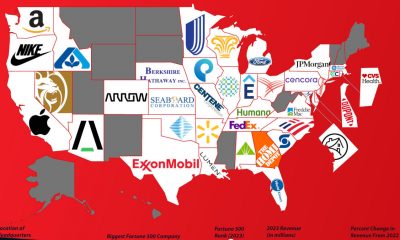
 Business Visualizations8 months ago
Business Visualizations8 months agoThe Biggest Fortune 500 Company in Every State
-

 Maps2 years ago
Maps2 years agoPenis Lengths Around the World
-
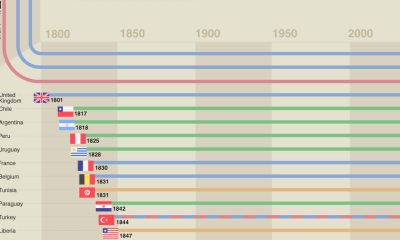
 Timelines2 years ago
Timelines2 years agoA History of the Oldest Flags in the World
-

 Business Visualizations2 years ago
Business Visualizations2 years agoAll The Brands Owned By PepsiCo
-
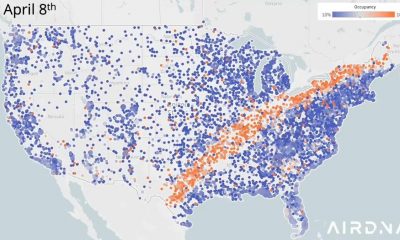
 Business Visualizations2 years ago
Business Visualizations2 years agoNew Animated Map Shows Airbnb’s Fully Booked Cities Along the 2024 Eclipse Path of Totality

